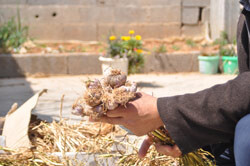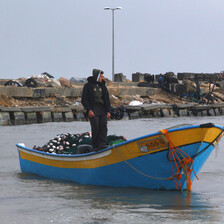The Electronic Intifada 3 December 2010

Rooftop farming (Eva Bartlett/IPS)
“Our family is large and thankfully what we grow feeds us,” he says. They grow a variety of staple vegetables.
“Cabbage and eggplants in winter, and endochriyya [a plant used for making soup] and chili and garlic and onions in summer. And other things that we can sell, like flowers and palm tree seedlings.”
The house is a typical cement block house, in the crush of a Palestinian refugee camp. “There is no space in camps, no trees, no public gardens,” Hamad says.
The flourish of greenery and color of his garden contrasts the utilitarian grey of their home and those close around it. Large blue plastic containers sprout date, orange and palm tree seedlings; parsley, cacti and peppers flourish.
“Our friends and guests like to sit up here, because most of them don’t have anything like this,” Hamad adds.
Hussein Shabat, director of the Palestinian Center for Youth Development, guides families working on rooftop garden projects, sometimes with the aid of outside donors.
“Beit Hanoun is an important place for such gardens. It’s near the border with Israel, and much agricultural land has been destroyed repeatedly by the Israeli army,” he says. The Palestinian Agricultural Relief Committee reports that up to 75,000 dunams (a dunam equals 1,000 square meters) of prime agricultural land has been destroyed by Israeli bulldozers and bombings.
“Also many farmers are unable to access their land because of the Israelis,” Shabat adds. The Israeli imposition of a “buffer zone” along Gaza’s borders swallows at least a third of Gaza’s farmland and renders lethal any border regions farmers try to access. This land formerly produced wheat, barley and a variety of fruits and nuts; it was Gaza’s food basket.
“Many people have left their homes and land near border areas, because they are afraid of the constant Israeli shooting and shelling attacks,” Shabat says. Beit Hanoun is now a waterless, treeless landscape.
On the flat, square, cement roof of another Beit Hanoun home, Ahed Shabat, 42, looks after the plants and vegetables growing in tubs and cement planters amidst hung laundry and water tanks.
“We grow things we can use year round, like garlic and onions,” he says. “But also seasonal plants like spinach, parsley, radishes, eggplant, corn, okra and chili peppers.
“We also grow flowers and herbs to use in tea, like mint, mirimiyya and zaatar,” he adds. The latter two herbs, that commonly grow wild in the hills of the occupied West Bank, are a staple for most Palestinians’ tea, and have medicinal uses.
The rooftop helps support his family of six, and is a tranquil island. “This garden is mostly for our family’s consumption, and at the same time saves us money,” Ahed Shabat explains. “My family enjoys sitting up here amongst the plants, because most of Beit Hanoun’s plant life has been destroyed.”
Home-grown food projects like rooftop gardens, and raising rabbits and chickens on the roof help combat the severe poverty of Gaza’s 80 percent food-aid dependent population. Those living in tightly-packed refugee camps or overcrowded towns but with access to a roof can potentially stave off malnutrition and at the same time generate a small income.
“I love raising birds,” says Abu Jihad, 17, at his rooftop coop of roughly 100 chickens and a score of pigeons in central Gaza. “In the beginning I learned about chickens watching how my friend worked with his coop. The only place I had to keep chickens was our roof.”
Abu Jihad’s chicken coop takes up the northeastern quarter, a ramshackle 1.5-by-3-meter pen of scavenged bits of wood, metal and chicken wiring, which he opens daily to let the birds run and peck all over the roof.
“I started with nine chicks my friend had given me, and bought another ten from pocket money that I’d saved. My family gave me a little more money to help out, so I bought another thirty.”
The business is not easy. “This spring there were cool winds in the morning. I only had basic materials for a simple cage which was very exposed. Some of my chicks died from the wind and exposure to the intense sun.”
Others became ill. “Medicine is very expensive, because of [Israel’s] siege, and I was already struggling just to bring them food. But I bought medicine, because they all would have died otherwise.”
Surviving a touchy start, his birds have multiplied and thrived. “Now I’ve got around fifty couples, and different types of chickens,” says Abu Jihad.
The eggs and meat are better quality than factory-farmed chickens, he says, because of the natural food he gives them. “I don’t feed them any steroids or chemicals, just vegetable peelings and dried bread and seeds, and I let them walk around on the roof every day.”
Some nongovernmental groups in Gaza do assist in such projects, but Abu Jihad took the initiative to start the project himself.
“I spent a lot of money starting with the birds, and didn’t earn anything from them for a long time. When I had more chickens and different types of chickens, I began to earn a little money. If my family didn’t need money, then I’d use the money from the eggs I sold to buy the birds food.”
What started as a project from fascination has developed into a relatively lucrative means of contributing to his family’s needs.
All rights reserved, IPS — Inter Press Service (2010). Total or partial publication, retransmission or sale forbidden.





